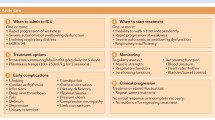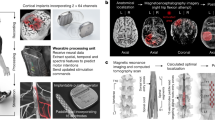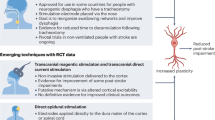Abstract
The examination of sacral reflexes provides an important method to differentiate an upper motor neuron vs lower motor neuron spinal cord injury (SCI). Two common sacral mediated reflexes used as part of the neurological assessment include the bulbocavernosus reflex (BCR) and anal reflex. As the clinical information from these tests are similar, we suggest that the anal reflex provides a better first option as a non-invasive clinical assessment of sacral reflex status in clinical practice in SCI as the testing for the anal reflex is less intrusive and already being performed as part of the International Standards for Neurological Classification of Spinal Cord Injury (ISNCSCI) by pinprick stimulation of the S4–5 dermatome.
Similar content being viewed by others
Introduction
Sacral reflexes are important diagnostic tools used for assessment of the sacral spinal cord integrity and can be very helpful in differentiating between upper motor neuron (UMN) and lower motor neuron (LMN) spinal cord lesions [1]. The bulbocavernosus reflex (BCR) and anal reflexes are the most commonly clinically used somato-somatic sacral reflexes [1]. While not a required part of the International Standards for Neurological Classification of Spinal Cord Injury (ISNCSCI) [2], or the International Standards to document remaining Autonomic Function after Spinal Cord Injury (ISAFSCI) [3], the BCR is described as an important test most especially in differentiating an UMN from a LMN injury [4, 5]. Here we describe these two sacral reflexes and explain the reasons for our recommendation for use of the anal reflex as the primary test for assessment of sacral reflex status in clinical spinal cord injury (SCI) practice.
UMN and LMN spinal cord injuries
UMN lesions cause a disruption of the descending motor pathways, leading to loss of voluntary motor control and inhibitory input to more caudal reflex arcs [6]. LMN lesions also cause the loss of motor control by affecting the axon or cell body in the peripheral nervous system [6]. Clinically, when an UMN lesion is present, this is characterized by spastic paralysis, hyperreflexia below the lesion, sensory loss, along with neurogenic bowel and bladder and sexual dysfunction [6]. Sacral reflexes to the lower gastrointestinal tract, bladder, and genitals remain intact, volitional control is impaired [6]. When a LMN lesion is present, this is manifested clinically as flaccid paralysis, sensory loss, absent lower limb deep tendon reflexes, and loss of sacral reflexes [6]. Management differences in terms of bowel, bladder, and sexual dysfunction, raise the importance of differentiation between lesion types [7,8,9,10].
Clinicians cannot fully determine whether a person has a LMN or UMN lesion by obtaining the motor, sensory or neurological level of injury from the performance of the ISNCSCI or ISAFSCI alone [6, 9, 11]. Additional neurologic examination is required including evaluating the sacral spinal segments. The two most commonly used sacral reflexes are the BCR and anal reflex that present with reflex contraction of the pelvic floor muscles in response to the stimulation of the perineum, urethra, bladder or anus [12]. Investigating these reflexes provide information about the sacral reflex arc innervation and function [13]. Understanding the details of each of these reflexes is important.
Sacral reflexes
Bulbocavernosus reflex (BCR)
Bors and Blinn first described the BCR in 1959 [14], which is also known as clitoroanal [15], penilo-cavernosus [16], and Osinski reflex [17]. Blaivas et al. [18] assessed the clinical utility of BCR and demonstrated a detectable reflex in 98% of able-bodied men and 81% of able-bodied females. However, in this study all patients with complete LMN lesions of the sacral spinal cord had absent BCR [18].
In women, different clinical methods have been described to elicit the BCR [12]. Gently ‘squeezing the clitoris’ [19], ‘tapping and squeezing the clitoris’ [20], ‘gentle tapping of the clitoris’ [21] and ‘gently touching the labium minus lateral to the clitoris’ resulting in anal sphincter contraction, have been described as methods for eliciting the BCR in women [12]. In men, the BCR is usually performed with the squeezing of the glans penis and observing anal sphincter contraction [14] or palpating the bulbocavernosus muscle contraction [22]. {See Fig. 1} Other effective stimuli to elicit this reflex have been described and include percussing the suprapubic area and observing anal sphincter contraction [23], or pulling the retention balloon of an indwelling Foley catheter against the bladder neck while a finger is inserted in the rectum [5, 18, 24].
The BCR is a multisynaptic spinal reflex mediated most commonly by root levels of S2–4 [25], although occasionally the synapses may lie as high as L5 [26] and the efferent innervation can include S5 [27, 28]. Afferent impulses are conveyed via the dorsal nerve of the penis/clitoris or perineal nerve [26, 29] and stimulate motor neurons of the external anal sphincter and bulbocavernosus muscles by the deep perineal [26, 29] and inferior hemorrhoidal branches of the pudendal nerve [30].
Anal reflex
Rossolimo [31] described the anal reflex and reported its constant appearance in normal subjects [32]. The anal reflex is also known as the anal wink [33], anocutaneous [34], and cutaneo-anal reflex [1, 35] and is a multisynaptic spinal reflex [36, 37] mediated mainly by S2–4 [38], while others report S2–5 [39,40,41]. The anal reflex has been also found to be a clinically feasible approach to assessment of sacral integrity [42] and a good predictor of recovery of the bladder and bowel functions in cauda equina syndrome [43]. The anal reflex is usually elicited with pinprick stimulation at the mucocutaneous junction of the anus and observing for anal sphincter contraction [32, 38]. Afferent pathways of the anal reflex lie in the pudendal nerve, which synapse in the spinal cord and travel via the inferior hemorrhoidal nerve to the external anal sphincter muscle [39,40,41]. Of key importance, the method to perform the anal reflex is the same examination technique recommended when performing the pinprick sensation at S4–5 as part of the ISNCSCI [2] (Fig. 2).
Similarities and comparison of sacral reflexes
Elicitation of the BCR and anal reflex can both be used to help differentiate an UMN vs LMN lesion [8, 10, 44]. Those persons with an intact BCR and/or anal reflex would represent having an UMN lesion and if absent, most likely a LMN lesion. However, there are some differences in these tests that the practitioner may consider in deciding which test to perform; including the additional time to perform the test as well as the discomfort of performing the reflex, for the patient and examiner. For testing of the BCR, it is required to squeeze the glans penis in men and most commonly touching the clitoris (or labium minus) in women to stimulate the reflex while checking for a reflex contraction of the external anal sphincter. The performance of this reflex can create some discomfort on the part of the individual being examined, most especially in women, as well as the professional performing the examination [45]. For the anal reflex, the testing of the S4-5 dermatome by a safety pin is already performed as part of the ISNCSCI, and as such, the examiner only needs to monitor for the visible contraction of the anal sphincter muscles during this test. As such, there is no need to perform another test to obtain this important information or to touch other areas of the body that may present discomfort to some individuals.
The performance of the BCR in females has also been described to be more difficult and therefore the significance of its absence may be more dubious [39]. Less consistent elicitation of clinically BCR even in healthy women, also makes this test less reliable [18]. The BCR has also been shown to be more difficult to elicit in circumcised men and in men with persistent foreskin retraction [46]. As such, it has been recommended that the BCR test may need to be repeated a number of times [10, 18]. While performing the BCR has been suggested in clinical practice [47] such a stimulus has been reported to be ‘somewhat painful’ to the patient [48]. Moreover, palpation of the bulbocavernosus muscle through the perineal skin can be difficult in obese patients and the contraction of this muscle may not easily be felt [48]. While some have advocated the use of electromyography induced BCR as a more objective method [49, 50], this is not feasible in the usual clinical care of patients.
There have been some recent publications regarding the consideration of adding (or not) the BCR to the ISNCSCI examination [4, 5, 51]. We agree that sacral reflexes are an important aspect of the clinical examination in SCI and should be tested. However, we suggest that whenever clinicians consider performing a sacral reflex test, consideration should first be to perform the anal reflex as opposed to the BCR. While there are differences regarding the reflexes from a neuroanatomical standpoint, both reflexes can be used to evaluate remaining functions after SCI as both assess the integrity of the sacral spinal cord segments. However, the procedure for the anal reflex is already being performed by the SCI examiner as part of the ISNCSCI, and as such a more clinically feasible approach to initially assess sacral integrity. If there is concern that the loss of the anal reflex may not completely offer the same information as the BCR, at that point the BCR can then be tested for confirmation.
Conclusion
Sacral reflexes are often helpful in differentiating UMN from LMN lesions in SCI. We suggest that the anal reflex as opposed to the BCR be considered as the primary sacral reflex test, as it provides a less invasive clinical assessment as it is already being performed as part of the ISNCSCI and offers similar information.
References
Uher EM, Swash M. Sacral reflexes: physiology and clinical application. Dis Colon Rectum. 1998;41:1165–77.
American Spinal Injury Association/ International Medical Society of Paraplegia. International standards for neurological and functional classification of spinal cord injury patients. 7th ed. Chicago, Illinois: ASIA; 2015.
Krassioukov A, Biering-Sorensen F, Donovan W, Kennelly M, Kirshblum S, Krogh K, et al. International standards to document remaining autonomic function after spinal cord injury. J Spinal Cord Med. 2012;35:201–10.
Previnaire JG. The importance of the bulbocavernosus reflex. Spinal Cord Ser Cases. 2018;4:2.
Alexander M, Aslam H, Marino RJ. Pulse article: how do you do the international standards for neurological classification of SCI anorectal exam? Spinal Cord Ser Cases. 2017;3:17078.
Doherty JG, Burns AS, O’Ferrall DM, Ditunno JF. Prevalence of upper motor neuron vs lower motor neuron lesions in complete lower thoracic and lumbar spinal cord injuries. J Spinal Cord Med. 2002;25:289–92.
Burns AS, Rivas DA, Ditunno JF. The management of neurogenic bladder and sexual dysfunction after spinal cord injury. Spine. 2001;26 Suppl 24:S129–36.
Clinical practice guidelines: neurogenic bowel management in adults with spinal cord injury. Spinal cord medicine consortium. J Spinal Cord Med. 1998;21:248–93.
Previnaire JG, Soler JM, Alexander MS, Courtois F, Elliott S, McLain A. Prediction of sexual function following spinal cord injury: a case series. Spinal Cord Ser Cases. 2017;3:17096.
Stiens SA, Bergman SB, Goetz LL. Neurogenic bowel dysfunction after spinal cord injury: clinical evaluation and rehabilitative management. Arch Phys Med Rehabil. 1997;78:S86–102.
Alexander MS, Marson L. The neurologic control of arousal and orgasm with specific attention to spinal cord lesions: integrating preclinical and clinical sciences. Auton Neurosci. 2018;209:90–99.
Wester C, FitzGerald MP, Brubaker L, Welgoss J, Benson JT. Validation of the clinical bulbocavernosus reflex. Neurourol Urodyn. 2003;22:589–91.
Wyndaele JJ. Correlation between clinical neurological data and urodynamic function in spinal cord injured patients. Spinal Cord. 1997;35:213–6.
Bors E, Blinn KA. Bulbocavernosus reflex. J Urol. 1959;82:128–30.
Campbell WW. The deep tendon or muscle stretch reflexes. In: Dejong’s The Neurologic Examination. 7th ed. Philadelphia: Kluwer Walters; 2013. p. 561–78.
Podnar S. Saddle sensation is preserved in a few patients with cauda equina or conus medullaris lesions. Eur J Neurol. 2007;14:48–53.
Vivek P. Acute spinal cord injury. In: Manipal manual of orthopaedics. 1st ed. London: Jaypee Brothers Medical; 2019. p. 110.
Blaivas JG, Zayed AAH, Labib KB. The bulbocavernosus reflex in urology: a prospective study of 299 patients. J Urol. 1981;126:197–9.
Chancellor MB, Blaivas JG. Neuro-urologic examination. In: Chancellor MB, Blavias JG, editors. Practical neuro-urology: genitourinary complications in neurologic disease. Boston, Oxford: Butterworth-Heinemann; 1995. p. 55–62.
Stanton SL. History and examination. In: Stanton SL, Monga AK, editors. Clinical urogynecology. 2nd ed. London: Churchill Livingstone; 2000. p. 77–84.
Khullar V, Cardozo L. History and examination. In: Cardozo L, Staskin D, editors. Textbook of female urology and urogynecology. United Kingdom: Taylor and Francis; 2001. p. 153–65.
Granata G, Padua L, Rossi F, De Franco P, Coraci D, Rossi V. Electrophysiological study of the bulbocavernosus reflex: normative data. Funct Neurol. 2013;28:293–5.
Hargrove GK, Bors E. The suprapubic abdominal tap reflex: a useful method to assess the function of the sacral reflex arcs. J Urol. 1972;107:243–4.
Cohen JM, Novick AK. Spinal cord injury rehabilitation and the ICU. In: Layon JA, Gabrielli A, Friedman WA, editors. Textbook of neurointensive care. 2nd ed. London: Springer; 2013. p. 676.
Vodušek DB. Neural control of pelvic floor muscles. In: Pelvic floor re-education. London: Springer London; 2008. p. 22–35.
Lapides J, Bobbitt JM. Diagnostic value of bulbocavernous reflex. J Am Med Assoc. 1956;162:971–2.
Ko HY, Ditunno JF, Graziani V, Little JW. The pattern of reflex recovery during spinal shock. Spinal Cord 1999;37:402–9.
Ko HY. Revisit spinal shock: pattern of reflex evolution during spinal Shock. Korean J Neurotrauma. 2018;14:47–54.
Yang CC, Bradley WE. Reflex innervation of the bulbocavernosus muscle. BJU Int. 2000;85:857–63.
Smith RP, Turek PJ. The Netter collection of medical iilustrations. Volume 1. In: Reproductive system. 2nd ed. Philadelphia, PA: Elsevier; 2011. p. 30
Rossolimo G. Der Analreflex, seine Physiologie und Pathologie. Neurol Cent. 1891;4:257–9.
Pedersen E, Harving H, Klemar B, Torring J. Human anal reflexes. J Neurol Neurosurg Psychiatry. 1978;41:813–8.
Alexander MS, Carr C, Chen Y, McLain A. The use of the neurologic exam to predict awareness and control of lower urinary tract function post SCI. Spinal Cord. 2017;55:840–3.
Sanders C, Driver CP, Rickwood AMK. The anocutaneous reflex and urinary continence in children with myelomeningocele. BJU Int. 2002;89:720–1.
Bartolo DCC, Jarratt JA, Read NW. The cutaneo-anal reflex: a useful index of neuropathy? Br J Surg. 1983;70:660–3.
Sinnatamby CS. Introduction to regional anatomy. In: Last’s Anatomy. 12th ed. London: Elsevier; 2011. p. 28–9.
Swash M. Early and late components in the human anal reflex. J Neurol Neurosurg Psychiatry. 1982;45:767–9.
Roberts MM. Neurophysiology in neurourology. Muscle Nerve. 2008;38:815–36.
Campbell WW. The superficial (cutaneous) reflexes. In: Dejong’s the neurologic examination. 7th ed. Philadelphia: Wolters Kluwer; 2013. p. 581.
Rodriguez G, King JC, Stiens S. Neurogenic bowel: dysfunction and rehabilitation. In: Braddom RL, Chan L, Harrast MA, editors. Physical medicine and rehabilitation. 4th ed. Philadelphia, PA: Saunders/Elsevier; 2011. p. 630.
Shiers S, Singal A, Korsten MA. Gastrointestinal system after spinal cord injury: assessment and intervention. In: Lin VW, Bono CM, editors. Spinal cord medicine, seconnd edition: Principles & Practice. 2nd ed. New York: Demos Medical; 2010. p. 395.
King JC, Currie DM, Wright E. Bowel training in spina bifida: importance of education, patient compliance, age, and anal reflexes. Arch Phys Med Rehabil. 1994;75:243–7.
Dhatt S, Tahasildar N, Tripathy SK, Bahadur R, Dhillon M. Outcome of spinal decompression in cauda equina syndrome presenting late in developing countries: case series of 50 cases. Eur Spine J. 2011;20:2235–9.
Donovan WH. The importance of the anal exam in neurologic classification of spinal cord injury. Spinal Cord Ser Cases. 2018;4:4.
Uff CE. Clinical assessment of cauda equina syndrome and the bulbocavernosus reflex (letter). https://www.bmj.com/rapid-response/2011/11/02/clinical-assessment-cauda-equina-syndrome-and-bulbocavernosus-reflex.
Podnar S. Clinical elicitation of the penilo-cavernosus reflex in circumcised men. BJU Int. 2012;109:582–5.
Lavy C, James A, Wilson-MacDonald J, Fairbank J. Cauda equina syndrome. BMJ 2009;338:b936.
Ertekin C, Reel F. Bulbocavernosus reflex in normal men and in patients with neurogenic bladder and/or impotence. J Neurol Sci. 1976;28:1–15.
Niu X, Wang X, Ni P, Huang H, Zhang Y, Lin Y, et al. Bulbocavernosus reflex and pudendal nerve somatosensory evoked potential are valuable for the diagnosis of cauda equina syndrome in male patients. Int J Clin Exp Med. 2015;8:1162–7.
Lee DG, Kwak SG, Chang MC. Prediction of the outcome of bladder dysfunction based on electrically induced reflex findings in patients with cauda equina syndrome: a retrospective study. Medicine. 2017;96:e7014.
Marino RJ. The anorectal exam is unnecessary! Spinal Cord Ser Cases. 2018;4:3.
Acknowledgements
We thank to Jason Bitterman MD for his figures drawn for this paper.
Funding
This study was supported in part a grant from the National Institute on Disability, Independent Living, and Rehabilitation Research (NIDILRR grant number 90SI5026).
Author information
Authors and Affiliations
Corresponding author
Ethics declarations
Conflict of interest
The authors declare that they have no conflict of interest.
Additional information
Publisher’s note Springer Nature remains neutral with regard to jurisdictional claims in published maps and institutional affiliations.
Rights and permissions
About this article
Cite this article
Kirshblum, S., Eren, F. Anal reflex versus bulbocavernosus reflex in evaluation of patients with spinal cord injury. Spinal Cord Ser Cases 6, 2 (2020). https://doi.org/10.1038/s41394-019-0251-3
Received:
Revised:
Accepted:
Published:
DOI: https://doi.org/10.1038/s41394-019-0251-3
This article is cited by
-
What is the clinical meaning of a negative bulbocavernosus reflex in spinal cord injury patients?
Spinal Cord Series and Cases (2022)
-
Bulbocavernosus or anal reflex, one or both should be tested after spinal cord injury
Spinal Cord Series and Cases (2020)
-
Neurogenic Bowel: Traditional Approaches and Clinical Pearls
Current Physical Medicine and Rehabilitation Reports (2020)





